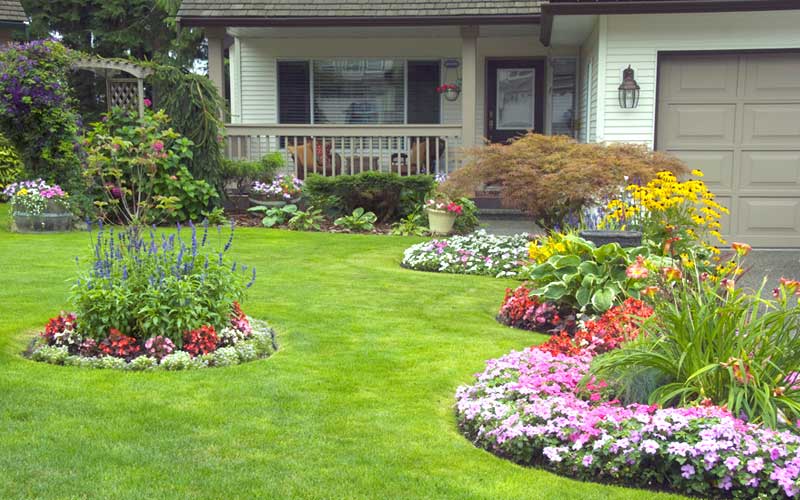

The landscape surrounding the house is an integral part of the home and should therefore reflect the lifestyle of the owners. Many people would like to have an attractive yard but neither have the time nor the desire to maintain a complicated landscaped garden. Yet neither a yard nor garden can look their best without dedicating a little time and attention. For this purpose, you can also hire an Orange County Landscaper to build the garden of your dreams. The following tips will help homeowners create a landscaped garden that requires minimum maintenance.
CHOOSE SUITABLE PLANTS
The time spent choosing suitable plants for the landscaping of the site surrounding the house represents a saving for the future. Shrubs sized to where they are planted will not need to be severely pruned to maintain their shape. When the seedlings have been chosen carefully, it is not necessary to replace or transplant trees that have become too tall or whose branches are too close to the house.
Choose trees and shrubs that require little pruning to maintain their natural shape. Plant free-growing hedges, which only need to be trimmed once a year. Buy high quality, healthy and disease resistant strains; you won’t have to spray repeatedly to protect your plants.
Choose “clean” trees and avoid those that always drop pods, fruits, twigs or leaves. These trees will require you to clean continuously throughout the season. Fruit trees often need spraying and they need to be pruned regularly to give good fruit, which can be a lot of extra work.
PLANT AND MULCH COVERS
Plant covers and mulches, which if used properly, reduce the maintenance required, retain moisture and prevent weeds from growing. They cannot completely replace lawn grasses, but in some places they are a low maintenance solution.
Ground covers are particularly useful in areas where it is difficult to grow sod (e.g. heavily shaded areas) or to mow (steep slopes). Plant covers can be chosen for their attractive foliage, flowers, fruits, or fall color.
Bark fragments and crushed stones are commonly used in flower beds to prevent weeds from growing and to make an attractive covering. If you are using stones or crushed rocks, make sure they will stay in the flower beds and not be a hazard when you pass the lawn mower.
Mulch around the base of a tree protects the trunk and shallow roots. Mulch prevents grass and seeds from growing and lessens the damage that lawn and edge mowers can do.
One of the main benefits of mulches is that they prevent weeds from growing. Black plastic used as mulch tends to fall apart and prevents water and nutrients from entering the soil. Synthetic fabrics are very efficient and do not break down as quickly as plastics. They hold the soil together and keep most weeds from growing, while allowing gases, water, and nutrients to enter the soil.
CREATE SMALL FLOWER BEDS
To reduce the maintenance required, plant small flower beds, which you can admire from inside or from the patio. Choose plants carefully to get the maximum color and effect. Arrange flower beds with straight edges or slightly curved to make it easier to walk the mower around. You can also use attractive containers for planting flowers and vegetables. These containers give color and don’t leave much room for weeds. The only problem is that container plantations have to be watered more often than flower bed plantings.
MARK THE EDGES OF THE PLATBANDS
Marking the edges of flower beds is a lot of work to start with, but reduces the maintenance required in the long run. This gives the flower beds a very neat appearance and prevents the grass from invading them. Materials like vinyl and rubber are flexible and curved to follow the shape of rounded flower beds. Wood, metal, concrete and brick 6 to 8 inches wide make attractive edges for plantings. The ledges should be level with the ground so as not to obstruct the passage of the mower and should be driven deep enough to prevent the rhizomes of the grass from invading the beds.
CREATE A HARMONIOUS LANDSCAPE
Plan the placement of trees, shrubs, flowers, and lawns to harmonize them. Grouping trees and shrubs together often gives a better effect than with isolated specimens. It also leaves more of the lawn free of obstacles, making it easier for the lawn mower to pass.
SET UP THE OUTSIDE STAYING AREAS
A large patio or a terrace makes the stay outside more pleasant and more comfortable. Although their initial cost is high, a patio or terrace represents a long-term investment in the pleasure of staying outdoors. Use an easy-to-maintain floor covering that doesn’t require a lot of annual work.
Reduce the maintenance work of children’s playgrounds and passageways by covering them with sand or gravel. These materials stand up to frequent trampling and require little maintenance.


